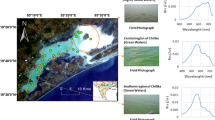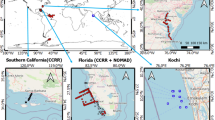Abstract
The backscattering coefficient (bb) has been obtained either in situ observations/measurements or semi-analytical/analytical and empirical algorithms that depend on the relationship between ‘bb’ and the remote sensing reflectance (Rrs). Several models were developed to estimate backscattering coefficient from the satellite imagery. The present study aims to assess the accuracy of bio-optical models and infer the best suitable model for Ocean Colour Monitoring (OCM-2) and for the upcoming OCM-3 sensors of Indian Space Research Organization. For this purpose, the bio-optical algorithms/models such as quasi-analytical algorithm (QAA), QAA version 5, Generalized Inherent Optical Properties (GIOP) and optimization of semi-analytical models in case 1 waters of the Bay of Bengal (BoB) were considered. For this analysis, three satellite sensors Moderate Resolution Imaging Spectroradiometer (MODIS)-Aqua, Visible Infrared Imaging Radiometer Suite (VIIRS), and OCM-2 datasets has been used to assess the model’s accuracy. The results showed that the optimization technique performs better (bias = 0.002, 0.179 and root-mean-square error (RMSE) = 8%, 20%) for MODIS-A and OCM-2, respectively, whereas GIOP performs better (bias = 0.08, RMSE = 14%) for VIIRS in case 1 waters of the BoB. From the statistical analysis of each model for all stations, it is recommended to use the optimization technique rather than GIOP technique for estimation of satellite based ‘bb’ in Indian waters.






Similar content being viewed by others
References
Boss, E., & Pegau, W. S. (2001). Relationship of light scattering at an angle in the backward direction to the backscattering coefficient. Applied Optics, 40(30), 5503–5507.
Bricaud, A., Babin, M., Morel, A., & Claustre, H. (1995). Variability in the chlorophyll-specific absorption coefficients of natural phytoplankton: Analysis and parameterization. Journal of Geophysical Research. https://doi.org/10.1029/95JC00463.
Carder, K. L., Hawes, S. K., Baker, K. A., Smith, R. C., Steward, R. G., & Mitchell, B. G. (1991). Reflectance model for quantifying chlorophyll a in the presence of productivity degradation products. Journal Geophysical Research, 96, 20599–20611.
Carder, K. L., Steward, R. G., Harvey, G. R., & Ortner, P. B. (1989). Marine humic and fulvic acids: Their effects on remote sensing of ocean chlorophyll. Limnology and Oceanography, 34, 68–81.
Doxaran, D., Cherukuru, R. C. N., & Lavender, S. J. (2006). Inherent and apparent optical properties of turbid estuarine waters: Measurements, modelling and application to remote sensing. Applied Optics, 45, 2310–2324.
Gordon, H. R., Brown, O. B., Evans, R. H., Brown, J. W., Smith, R. C., Baker, K. S., et al. (1988). A semi-analytical radiance model of ocean colour. Journal Geophysical Research, 93, 10909–10924.
Hoge, F. E., & Lyon, P. E. (1996). Satellite retrieval of inherent optical properties by linear matrix inversion of oceanic radiance models: An analysis of model and radiance measurement errors. Journal Geophysical Research, 101, 16631–16648.
IOCCG. (2006). Remote sensing of inherent optical properties: fundamentals, tests of algorithms, and applications. In Z. P. Lee (Ed.), Reports of the International Ocean-Colour Coordinating Group (No. 5, pp. 126). Dartmouth, Canada: IOCCG.
Lee, Z. P., Carder, K. L., & Arnone, R. A. (2002). Deriving inherent optical properties from water colour: A multiband quasi-analytical algorithm for optically deep waters. Applied Optics, 41(27), 5755–5772.
Lee, Z. P., Carder, K. L., Chen, R. F., & Peacock, T. G. (2001). Properties of the water column and bottom derived from AVIRIS data. Journal Geophysical Research, 106, 11639–11652.
Lee, Z. P., Carder, K. L., Hawes, H. K., Steward, R. G., Peacock, T. G., & Davis, C. O. (1994). Model for the interpretation of hyperspectral remote-sensing reflectance. Applied Optics, 33(24), 5721–5732.
Lee, Z. P., Carder, K. L., Mobley, C. D., Steward, R. G., & Patch, J. S. (1999). Hyperspectral remote sensing for shallow waters: 2. Deriving bottom depths and water properties by optimization. Applied Optics, 38, 3831–3843.
Lee, Z. P., Darecki, M., Carder, K. L., Davis, C. O., Stramski, D., & Rhea, W. J. (2005). Diffuse attenuation coefficient of down-welling irradiance: An evaluation of remote sensing methods. Journal of Geophysical Research. https://doi.org/10.1029/2004JC002573.
Lee, Z. P., Lubac, B., Werdell, P. J., & Arnone, R. (2009). An update of the quasi-analytical algorithm (QAA_v5). Technical report: International Ocean Colour Coordinating Group (IOCCG). http://www.ioccg.org/groups/software.html
Lee, Z. P., Weidemann, A., Kindle, J., Arnone, R. A., Carder, K. L., & Davis, C. (2007). Euphotic zone depth: Its derivation and implication to ocean colour remote sensing. Journal Geophysical Research. https://doi.org/10.1029/2006JC003802.
Marshall, B. R., & Smith, R. C. (1990). Raman scattering and in-water ocean optical properties. Applied Optics, 29(1), 71–84.
McKee, D., Chami, M., Brown, I., Calzado, V. S., Doxaran, D., & Cunningham, A. (2009). Role of measurement uncertainties in observed variability in the spectral backscattering ratio: A case study in mineral-rich coastal waters. Applied Optics, 48, 4663–4675.
Mobley, C. D. (1994). Light and Water. Academic, San Diego, Calif: Radiative Transfer in Natural Waters.
Morel, A. (1974). Optical properties of pure water and pure seawater. In N. G. Jerlov & N. E. Steemann (Eds.), Optical aspects of oceanography (pp. 1–24). New York: Academic.
Morel, A., & Gentili, B. (1993). Diffuse reflectance of oceanic waters, 2, bi-directional aspects. Applied Optics, 32, 6864–6879.
Pope, R. M., & Fry, E. S. (1997). Absorption spectrum 380–700 nm of pure water. II. Integrating cavity measurements. Applied Optics, 36, 8710–8723.
Prasad, T. D. V., Latha, T. P., Rao, K. H., Choudhury, S. B. & Nagamani P. V. (2012). Processing of oceansat-2 ocean colour monitoring data using SeaDAS. Technical report. NRSC/ECSA/AOSG/OSD/Dec2012/TR-488.
Preisendorfer, R. W. (1976). Introduction, Vol. 1 of Hydrologic Optics. Nat. 327 Tech. Inf. Service, Springfield, VA, USA. NTIS PB-259 793_8ST.
Sun, D., Li, Y., Wang, Q., Gao, J., Lv, H., Le, C., et al. (2009). Light scattering properties and their relation to the biogeochemical composition of turbid productive waters: A case study of Lake Taihu. Applied Optics, 48, 1979–1989.
Werdell, P. J., Franz, B. A., Bailey, S. W., Feldman, G. C., Boss, E., et al. (2013). Generalized ocean color inversion model for retrieving marine inherent optical properties. Applied Optics, 52, 2019–2037.
Acknowledgements
We thank Dr. V.K. Dhadwal, former Director, NRSC, Dr. Santanu Chowdhury, Director, NRSC and Dr. M. V. R. Sesha Sai, Deputy Director, ECSA and Program Director, NICES for their consistent support and encouragement to carry out this work. The authors would like to express their sincere thanks to Dr. Harish Kumar, Chief Scientist, NPOL, Kochi, for providing the opportunity to participate in this cruise, Navy Officers onboard and the respective collaborators for participating in the cruise for collecting the data support and co-operation to carry out this work in a big way.
Author information
Authors and Affiliations
Corresponding author
About this article
Cite this article
Baranval, N.K., Nagamani, P.V., Rama Rao, P. et al. Accuracy Assessment of Bio-optical Models to Retrieve Backscattering Coefficients in Case 1 Waters of the Bay of Bengal. J Indian Soc Remote Sens 47, 527–535 (2019). https://doi.org/10.1007/s12524-019-00937-3
Received:
Accepted:
Published:
Issue Date:
DOI: https://doi.org/10.1007/s12524-019-00937-3




